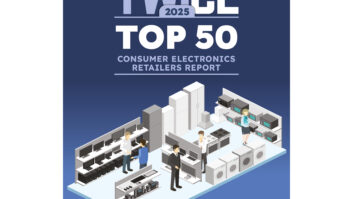TWICE: What other successful strategies should dealers pursue?
Bodley: The independent specialist, in adopting a strategy to survive against the large box retailer, has moved into custom, but the specialists’ challenge in introducing the technology to new and previous customers flowing through the store has become increasingly difficult. When you do custom installation correctly, you really don’t see it, so how do you merchandise and display the concept to the consumer?
If you were to walk into the stores of many better retailers, it is almost impossible to tell that they are in the business. You don’t see any presentation. They fool around with a teeny living room vignette idea, and when they put a volume control here, a keypad there, speakers there. It’s too fragmented.
A retailer I worked for built a 2,000-square-foot home within a store and completely furnished it. And I would go in on the weekends to see how the concept worked. What was amazing was that consumers didn’t notice the installed product; they thought we were selling furniture, and the salesman would explain that we’re selling home theater, music throughout the house, and you don’t have to see the speakers anymore. It was a constant battle. They couldn’t easily understand what we were doing.
What I’ve done in my installation company is create focused displays on different technologies, so that, as we converse with the customer, we can separately show them telephone, lighting, security and whole-house audio.
Many retailers line up custom products as if in a supermarket. That contributes to the perception that one could go to another supermarket that lines up products to pick a product that’s nicer looking and cheaper. But at my installation company, consumers are evaluating it from a different set of rules. Rather than walk in and say they already know what they want, they want to know how we do what we do without being intimidated.
Sterns: Taking that a step farther, I think most consumers are more concerned about picking someone they trust to cut holes in their walls than they are considering which VCR is better. We have to remember what we are really selling: design installation first, product second. If we just give product choices, then the consumers are not being sold.
Bodley: You are right. When the consumer is informed enough to know that the custom electronics design and installation industry exists, I agree with you totally. The problem is that, if you stop 90% of the people on the street, they don’t know that custom installation exists, so I believe the goal is raising the awareness of the retail consumer who is coming in to buy a box and go. With a good display, consumers will learn that when someone rings the doorbell, the TV will show the person at the front door, and then they can pick up the phone to talk to them. They don’t care what product it is. They just want to be able to do it.
Goldstein: One of the things that a custom installer needs to do is to make every job less custom. Putting together a core set of systems that you understand fully is a great boon for success.
The other opportunity I see, as this becomes more mass marketable, is a huge amount of opportunity in the $10,000 to $20,000 media center, AV room, whatever you want to call it. That’s where you can get in, get out, collect your money, and be profitable.
Some of the most successful AV contractors are the ones who have nailed it down to an equation. One of the guys who just continually grosses business, is profitable and is easy to do business with is not the guy doing a $200,000 theater or a multi-room system. He focuses on doing really nice media rooms. There are more potential customers at that price range.
Harary: It is a good idea to focus on one or two control systems so you really understand them and maximize their operation, but I think, as you begin to formulate packages to the point where you walk into a customer’s home and say, “Oh, yes, you need System 2,” then the more you begin to commoditize the business and the sooner you will have to take your services up a notch.
Sterns: When you’re looking at it from a product point of view, I agree with you, but when you are looking at it from a service and design point of view, I would disagree. Which is to say there are different levels of in-walls and volume controls that can be sold in a package concept. Much like a car stereo, you can have a full-blown custom design or a deck-and-four.
I think there’s a parallel for that in the custom business, starting with a relatively simple installed system for consumers who want background sound throughout the house but don’t want to put [an enclosed speaker] in every room.
That basic system needs to be packaged in such a way that it can be repeatable and profitable, to the extent that different housing construction allows. I think that’s where Jeff was going.
Sheldon: Five years ago, CEDIA got these competitions going in which the industry would vote for its favorite systems. There was a mad race to see who could ring up the largest sale, and a lot of people fell into that trap of landing a job for which they wrote a billing far beyond anything they had done before and couldn’t install that system profitably. I’ve seen this mad chase towards high-dollar-volume systems really go away over the past few years.
I’ve seen companies say, here’s a realistic expectation for what I can bid and competently install. These include the people who focus on tract work, and they are doing relatively low-tech distributed-audio systems, but they have a formula in place, and they can make that formula work profitably for their company, and that’s where, I think, cookie-cut design becomes important.
TWICE: Mass customization.
Sheldon: They have a relationship with their suppliers. They can manage inventory effectively. Their employees are comfortable with the products in their van. They are not learning how to hook up a different system every day.
Ekblad: The repeatability concept is important to us. We start with what we do best, home theater, and look to add rooms to the home theater sale. If I have templated, repeatable systems that I can add to a home theater sale, the salesperson doesn’t have to re-invent the wheel each time he goes to sell this product. Instead, he knows that if he sells this concept with this product, it’s going to work every time. But if he tries to stretch the template, say if you add this to that system, the customer is going to experience these problems.
We have done this. We know how it works, and we can make recommendations that will build on the strengths that we have developed in the past. I don’t think it becomes a package.
Bodley: The key to successful relationships is developing not just a relationship to sell now but a relationship for a lifetime to the point where the new competition doesn’t bother me.
TWICE: If a consumer knows that you know their house and system inside out, they are going to come back to you?
Bodley: Correct. It’s the barrier to exit. The customer would have to start all over to develop the same relationship with another company to get the same relationship they already have with my company. So the burden is on the installer to keep their customers close to them through information and promotion.












